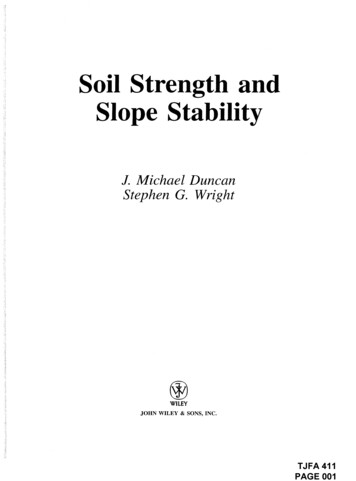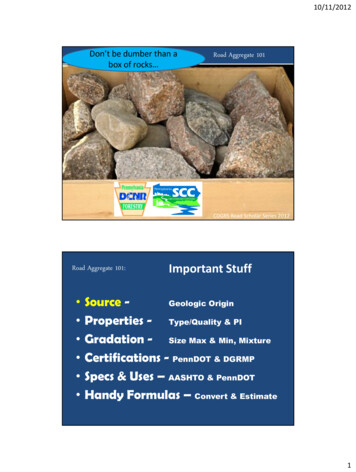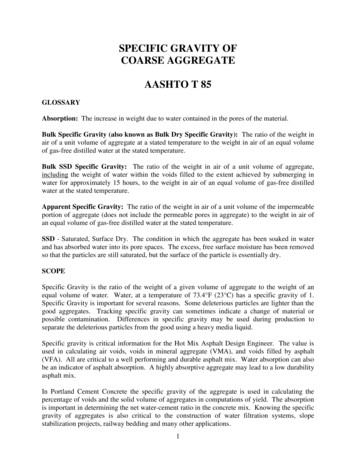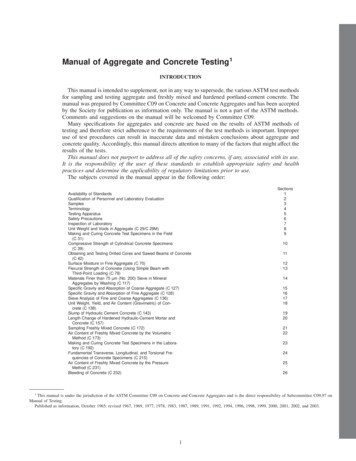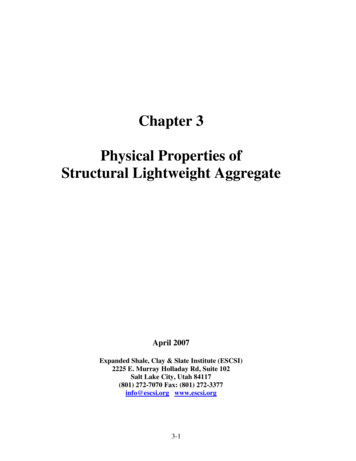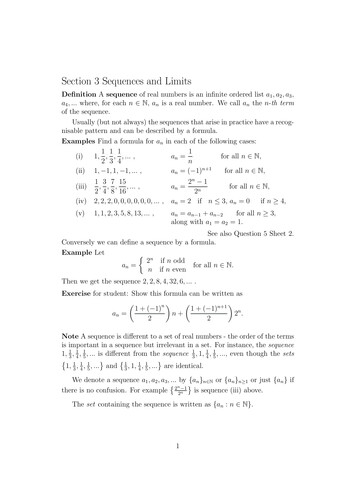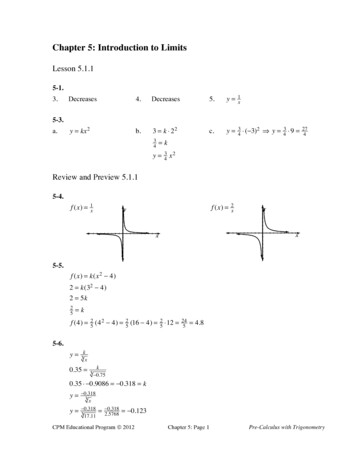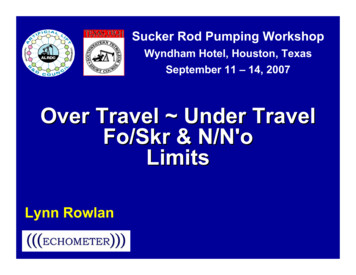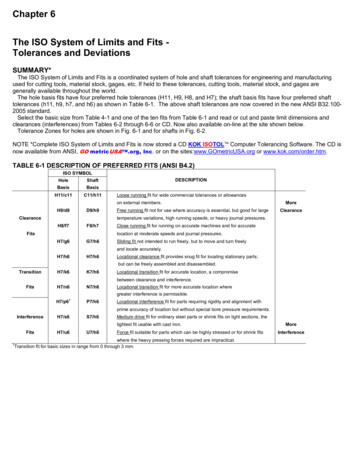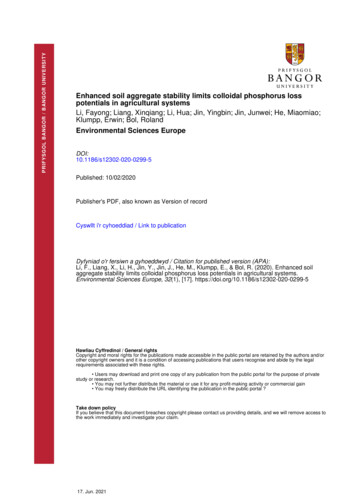
Transcription
PRIFYSGOL BANGOR / B ANGOR UNIVERSITYEnhanced soil aggregate stability limits colloidal phosphorus losspotentials in agricultural systemsLi, Fayong; Liang, Xinqiang; Li, Hua; Jin, Yingbin; Jin, Junwei; He, Miaomiao;Klumpp, Erwin; Bol, RolandEnvironmental Sciences EuropeDOI:10.1186/s12302-020-0299-5Published: 10/02/2020Publisher's PDF, also known as Version of recordCyswllt i'r cyhoeddiad / Link to publicationDyfyniad o'r fersiwn a gyhoeddwyd / Citation for published version (APA):Li, F., Liang, X., Li, H., Jin, Y., Jin, J., He, M., Klumpp, E., & Bol, R. (2020). Enhanced soilaggregate stability limits colloidal phosphorus loss potentials in agricultural systems.Environmental Sciences Europe, 32(1), [17]. https://doi.org/10.1186/s12302-020-0299-5Hawliau Cyffredinol / General rightsCopyright and moral rights for the publications made accessible in the public portal are retained by the authors and/orother copyright owners and it is a condition of accessing publications that users recognise and abide by the legalrequirements associated with these rights. Users may download and print one copy of any publication from the public portal for the purpose of privatestudy or research. You may not further distribute the material or use it for any profit-making activity or commercial gain You may freely distribute the URL identifying the publication in the public portal ?Take down policyIf you believe that this document breaches copyright please contact us providing details, and we will remove access tothe work immediately and investigate your claim.17. Jun. 2021
(2020) 32:17Li et al. Environ Sci Eurhttps://doi.org/10.1186/s12302-020-0299-5Open AccessRESEARCHEnhanced soil aggregate stabilitylimits colloidal phosphorus loss potentialsin agricultural systemsFayong Li1,2, Xinqiang Liang1* , Hua Li3, Yingbin Jin1, Junwei Jin1, Miaomiao He4, Erwin Klumpp5and Roland Bol5,6AbstractBackground: Colloid-facilitated phosphorus (P) transport is recognized as an important pathway for the loss of soilP in agricultural systems; however, information regarding soil aggregate-associated colloidal P ( Pcoll) is lacking. Toelucidate the effects of aggregate size on the potential loss of Pcoll in agricultural systems, soils (0–20 cm depth) fromsix land-use types were sampled in the Zhejiang Province in the Yangtze River Delta region, China. The aggregate sizefractions (2–8 mm, 0.26–2 mm, 0.053–0.26 mm and 0.053 mm) were separated using the wet sieving method. Colloidal P and other soil parameters in aggregates were analyzed.Results: Our study demonstrated that 0.26–2 mm small macroaggregates had the highest total P (TP) content.In acidic soils, the highest Pcoll content was observed in the 0.26- to 2-mm-sized aggregates, while the lowest wasreported in the 0.053 mm (silt clay)-sized particles, the opposite of that revealed in alkaline and neutral soils. Paddysoils contained less Pcoll than other land-use types. The proportion of Pcoll in total dissolved P (TDP) was dominatedby 0.053 mm (silt clay)-sized particles. Aggregate size strongly influenced the loss potential of P coll in paddy soils,where Pcoll contributed up to 83% TDP in the silt clay-sized particles. The Pcoll content was positively correlated withTP, Al, Fe, and the mean weight diameter. Aggregate-associated total carbon (TC), total nitrogen (TN), C/P, and C/Nhad significant negative effects on the contribution of Pcoll to potential soil P loss. The Pcoll content of the aggregateswas controlled by the aggregate-associated TP and Al content, as well as the soil pH value. The potential loss of P collfrom aggregates was controlled by its organic matter content.Conclusion: We concluded that management practices that increase soil aggregate stability or its organic carboncontent will limit P coll loss in agricultural systems.Keywords: Soil aggregate, Colloidal phosphorus, pH, Geometric mean diameter, Loss of phosphorusBackgroundThe loss of phosphorus (P) from agricultural soils hasbeen identified as one of the main causes of eutrophication of lakes in the lower reaches of the Yangtze Riverin southern China [1]. Statistics have shown that majorlakes and reservoirs in this area were eutrophic and*Correspondence: liang410@zju.edu.cn1College of Environmental and Resources Sciences, Zhejiang University,Hangzhou 310058, ChinaFull list of author information is available at the end of the articlemesotrophic [2–4], and the Yangtze River Delta regionaccounted for 17% of the 10 Tg annual increase in soilP around the world [2]. In soil, colloidal P (Pcoll) is theP fraction bound to colloids [5]. Colloidal particles arehighly mobile and are effective adsorbents of organic andinorganic contaminants and nutrient elements, such as P,owing to the high specific surface area and charge density [6, 7]. Colloid-facilitated P transport is an importantpathway for the migration of P into water bodies [5, 8, 9].One study has reported that more than 75% of P in cultivated soil solution is combined with fine particles smaller The Author(s) 2020. This article is licensed under a Creative Commons Attribution 4.0 International License, which permits use, sharing,adaptation, distribution and reproduction in any medium or format, as long as you give appropriate credit to the original author(s) andthe source, provide a link to the Creative Commons licence, and indicate if changes were made. The images or other third party materialin this article are included in the article’s Creative Commons licence, unless indicated otherwise in a credit line to the material. If materialis not included in the article’s Creative Commons licence and your intended use is not permitted by statutory regulation or exceeds thepermitted use, you will need to obtain permission directly from the copyright holder. To view a copy of this licence, visit http://creat iveco mmons .org/licen ses/by/4.0/.
Li et al. Environ Sci Eur(2020) 32:17than 240 nm [10]; similarly, 40–58% of molybdate-reactive P, with a size less than 450 nm in the water extractof grassland soil, demonstrates fine-grained P with a sizeof 25–450 nm [9]. Other studies have suggested that Pcollreached up to 50% of total P (TP) in surface runoff, rivers,and lakes [11], which may lead to environmental risks.Soil aggregate stability plays a key role in controllingthe erosion processes and the loss of soil nutrients [12–14]. Water-dispersible colloids in the soil adhere to soilaggregates, forming a stable system [15]. Colloids eithercan bind to soil aggregates, or be physically strained fromwater flowing through pores between aggregates [16, 17].Some scholars determined the colloid content in 1–2 mmaggregates in 39 soils and revealed a significant positivecorrelation between the water-dispersible colloid contentand clay content in soil aggregates [18]. Furthermore,they reported that water-dispersible colloid content was afunction of total organic C and total clay. Other scholarsmodeled the release characteristics of colloids from soilaggregates, the attachment and detachment processes atthe air–water interface, and flocculation and strainingfrom interstitial water [19]. The release of colloids fromaggregates may result in the disintegration of aggregates[20]. However, soil aggregation mainly depends on theavailability of active mineral surfaces and the dispersion/flocculation behaviors of the colloidal components [21].Meanwhile, the degree of clay colloid dispersion can bereduced by increasing the aggregate stability [18, 22, 23].Therefore, the stability of soil aggregates directly affectsthe migration of soil colloids.The retention of P in soil aggregates depends on theaggregate sizes and chemical properties [24, 25]. Notably,P has a relatively closed cycle, with most of the mineralized and dissolved P from microaggregates adsorbedonto unaggregated clay-sized particles ( 53 μm) or utilized by plants [26]. Reportedly, some studies have shownthat the soil aggregate stability and size affect the soil Pdistribution [27–29]. Higher percentages of both waterextractable and Mehlich III-extractable P were observedin both the 0.50–0.25 and 0.25–0.125 mm aggregate fractions [30]. In contrast, reports have suggested that TP isthe highest in small soil aggregates [31], or the TP content is uniform in soil aggregates of all sizes, whereasavailable P is higher in small soil aggregates [32]. Soilaggregation could reduce the loss of organic P in aggregates and increase the adsorption of inorganic P by siltand clay particles [26]. Meanwhile, the P forms in soilaggregates may vary with different particle sizes andland-use types [24, 33]. For example, a study has indicated that aluminum oxide bond P (Al–P) is mainlydominated by soil aggregates 1 mm; those of 2–8 mmwere mainly iron oxide bond P (Fe–P) and calcium oxidebond P (Ca–P) [34]. Other investigators have claimedPage 2 of 14that the labile P in macroaggregates was higher undernative land-use than other land uses, further confirmingthat soils under native use contained more Ca-bound Pin macroaggregates than the disturbed soils [35]. Thesestudies provide the first basis for the better understanding the relationship between soil aggregates and P.To date, information on the Pcoll content and its losspotential from aggregates remains limited. The impactof the aggregation process on the Pcoll content in soilsremains unclear. Moreover, the composition and structure of soil aggregates vary under different land-use management [36, 37]. There are fewer large-sized aggregatespresent in rice soil than dryland due to long-term flooding and anaerobic conditions that cause the macroaggregates to be dispersed [36, 38]. In addition, alternationbetween dry and wet conditions generally destroys macroaggregates and enhances the decomposition of organiccarbon in paddy soils [39]. Therefore, we suspected thatthe content of P coll in the macroaggregates of paddy soilswas less than dryland soils, mainly existing in microaggregates and small particles, with a higher loss potential.This study mainly aimed to understand the effect ofsoil aggregate stability on soil P coll content and its losspotential, and to assess the core environmental factorsaffecting Pcoll in soil aggregates. Hence, we collected soilsamples from 15 sites and 6 land-use types in the Yangtze River Delta region, Zhejiang Province for aggregatesand Pcoll analysis. Firstly, we isolated the different-sizedaggregates in the soil samples. Secondly, we determinedthe Pcoll, total carbon (TC), TP, total nitrogen (TN), Al,Fe, and Ca content in each aggregate size fractions. Wehypothesized that (1) larger sized aggregates have higherTP and P coll content; (2) aggregates with a higher TC content have lower loss potential of Pcoll, and (3) land-usemanagement with single rice has a higher loss potentialof Pcoll.Materials and methodsSoil sampling and preparationIn total, soils with different land-use types (Fig. 1) werecollected from 15 sites, which were almost evenly distributed in the Zhejiang Province (an area of 1,055,000 km2).Information on specific sampling points is presented inTable 1. The 15 sampling points covered six land-usetypes including orchards, single cropping rice, doublecropping rice, rice–rape rotation, rice–wheat rotation,and vegetables, generally established in the past 5 years.Soil samples of 0–20 cm were collected from typicalfields (long-term farmland with conventional fertilization by local farmers) in May 2018 during the second season of rotation systems and in other land-use types. Twosamples, with three replicates, were obtained at intervals of 1000 m at each site with the same land-use type.
Li et al. Environ Sci Eur(2020) 32:17Fig. 1 Location of sampling sites. Location sites of S1–S15correspond to Kaihua, Kecheng, Longquan, Zhuji, Lingxi, Changshan,Qiandaohu, Liandu, Tonglu, Zhoushan, Wuxing, Tiantai, Shengzhou,Mazhan, and Luqiao in Zhejiang Province, China, respectivelyNext, the replicates were brought back to the laboratoryand mixed. Then, the mixed soil samples from each sitewere divided into four equal parts by the diagonal quartering method and maintained for a follow-up test. Allsamples were air-dried and separated into two parts:one was finely milled and sieved through a 2-mm meshto determine basic physical and chemical properties, andthe other was carefully broken into small pieces manuallyand passed through an 8-mm sieve for aggregate separation and Pcoll determination.Aggregate separation and determinationAggregate size distribution was determined for eachsoil sample using a modified wet sieving method [40].Briefly, 50 g of unground soil, passed through an 8-mmsieve, was carefully placed above a nest of three sieves(2 mm, 0.26 mm, and 0.053 mm). Then, the sieves weresubmerged for 20 min in 2.5 L deionized water at roomtemperature and oscillated 300 times for 10 min with a30-mm amplitude to separate aggregate fractions. Thus,four aggregate fractions were obtained on each sieve:large macroaggregates (2–8 mm), small macroaggregates(0.26–2 mm), microaggregates (0.053–0.26 mm), and(silt clay)-sized particles ( 0.053 mm) [41]. Aggregatesof each size were carefully removed from the sieve andplaced into a beaker. The water used for wet sieving wasleft to rest for 48 h, silt and clay particles were collected,and the supernatant was used to determine total dissolved P (TDP), truly soluble P (TSP), and Pcoll content.Page 3 of 14All aggregates were oven-dried at 65 C for 48 h, weighed,and placed in a zip lock bag. To obtain water-stable aggregates, the sediment concentration was subtracted fromthat obtained by wet sieving as sand was not considereda component of water-dispersible aggregates [40]. Thesand content was determined by the following process:5 g of the dry aggregates obtained above were weighed,dispersed into 30 mL 5 g L 1 hexametaphosphate solution, placed into an ultrasonic cleaner, and dispersed for30 min. The suspension was then poured
sand content was determined by the following process: 5g of the dry aggregates obtained above were weighe, dispersed int30L5g L 1 hexametaphosphate solu-,aced into an ultrasonic cleaner,spersed for 30.spension was then poured through a nest of sieves.esidue left on t0.053-ve repre - sented the sand content of each sized aggregat.Ater
